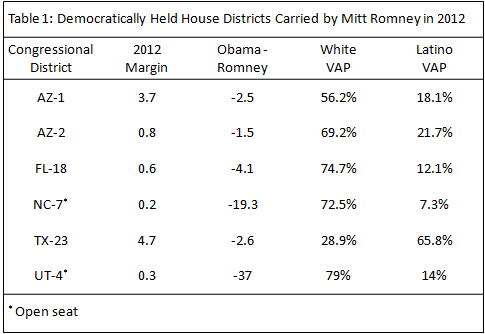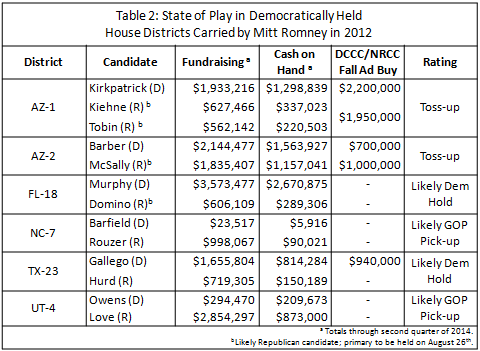In a prior post, I drew on new polling conducted by Latino Decisions on behalf of the Center for American Progress Action Fund examining Latino voters’ attitudes towards executive action on immigration to consider how such action might affect the political context moving into the 2014 elections. The analysis suggests that the House Republicans’ decision to abandon comprehensive immigration reform provides an opportunity for the Democrats to make further inroads with Latino voters. However, if the president does not act, Latinos’ enthusiasm for voting in November will decrease along with their support for Democrats.
Yet, because the poll uses a national sample, assessing where executive action may matter in the 2014 election is unclear. Moreover, except for the Senate races in Colorado and perhaps Georgia, Michigan, and North Carolina, there are few competitive federal statewide races where Latino voters are positioned to be influential. As a consequence, any electoral advantages that the Democrats may gain may be limited to the House of Representatives.
As I have written previously, the inability of the Democrats to either recruit or fund quality challengers to compete against vulnerable Republicans representing districts with significant voting age Latino populations means that the biggest beneficiaries of executive action on immigration may be vulnerable House Democrats running in Latino influence districts. In what follows, I examine if executive action may matter in what are arguably the most difficult seats for the Democrats to defend this cycle: the six districts carried by Mitt Romney in 2012. Table 1 summarizes these districts’ 2012 margins for both the House and presidential elections and the share of the districts’ voting age population that is white and Latino using data from the 2010 US Census.

Unfortunately for the Democrats, because of retirements, two of the six are open seats. Democrats who are running to replace Mike McIntyre (NC-7) and Jim Matheson (UT-4) are well behind their Republican opponents in the money chase (see Table 2, which summarizes candidates’ fundraising totals through the second quarter and any airtime reserved by the party’s congressional campaign committees). This, coupled with the districts’ strong support for Romney in 2012, suggest likely Republican pick-ups; a perspective shared by both the DCCC and the NRCC, as neither committee is planning to invest in these districts.
The Democrats are, however, likely to hold the heavily Latino 23rd district in Texas that stretches west from San Antonio to El Paso County. Incumbent Pete Gallego will be running against Will Hurd, who defeated former House member Francisco “Quico” Canseco in a May primary runoff. Canseco narrowly lost the seat to Gallego in 2012.
The Democrats are also well positioned in FL-18. Incumbent Patrick Murphy has the advantage of a late August primary that is being contested by a bevy of Republicans. Among the eight announced Republicans, only former state Representative Carl Domino has significant cash on hand ($289,306 at the end of the first quarter, but also $425,000 in debt). Meanwhile, Murphy has nearly $2.7 million in cash on hand. Neither congressional campaign committee has reserved airtime for the race.

The two Arizona districts, the 1st and 2nd, held by Democrats Ann Kirkpatrick and Ron Barber respectively, are likely to be two of the most competitive races in the 2014 cycle. Although Arizona’s late primary may provide some advantage for the Democratic incumbents, the NRCC recruited in both districts and has reserved substantial airtime in both districts for the fall. In AZ-1, the NRCC included two of the four Republican candidates, Gary Kiehne and Andy Tobin, in its “On the Radar” program, while retired Air Force Colonel Martha McSally, the likely GOP candidate in AZ-2, has been elevated to the NRCC’s “Young Guns” program. More significantly, through the end of the second quarter, McSally raised over $1.8 million with over $1.1 million in cash on hand.
In sum, among the six Democratically held districts carried by Romney in 2012, Republicans are likely to pick-up two (NC-7 and UT-4), and two are likely to remain Democratic (FL-18 and TX-23). In light of these dynamics, there is little reason to expect executive action on immigration will have any effect on those outcomes. The two toss-up districts (AZ-1 and AZ-2), however, suggest contexts where executive action and Latino voter preferences may be decisive. In my next post, I will take a closer look at AZ-1 and AZ-2 to consider how executive action and immigration policy more generally may matter come November.
David Damore is a senior analyst at Latino Decisions, Associate Professor of Political Science at the University of Nevada Las Vegas, and a Senior Nonresident Fellow in the Brookings Institution’s Governance Studies Program.


